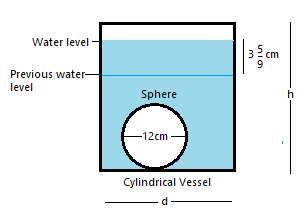
A sphere of diameter 12cm, is dropped in a right circular cylindrical vessel, partly filled with water. If the sphere is completely submerged in water, the water level in the cylindrical vessel rises by $3\dfrac{5}{9}cm.$ Find the diameter of the cylindrical vessel.
Answer
606.3k+ views
Hint: Directly consider the volume of water level raised in terms of cylindrical vessel’s volume of height equal to water level raised. It can easily be equated with the volume of the sphere to calculate the diameter of a cylindrical vessel.
Complete step-by-step answer:
Here, as per the given conditions, a sphere of diameter = 12cm is submerged into a cylindrical vessel partly filled with water, after sphere is dropped in vessel the water level rises by $3\dfrac{5}{9}cm$, i.e.,

Let’s say, height of cylinder be $h$cm and diameter of cylindrical vessel be $d$cm, or radius of cylindrical vessel be $\dfrac{d}{2}={{r}_{c}}$cm and diameter of sphere is $12cm$, or radius of sphere = ${{r}_{s}}=\dfrac{12}{2}=6cm$.
Since the volume of water inside the cylindrical vessel remains the same, the rise in water level is definitely caused by an additional volume of sphere. Thus, we can say that
$\Rightarrow $ Volume of water raised = volume of sphere submerged into the cylindrical vessel, i.e.,
$\Rightarrow $ Volume of cylinder with height, ${{h}_{waterlevel}}=\left( 3\dfrac{5}{9} \right)cm$ with radius $\left( {{r}_{c}} \right)$cm = volume of sphere of radius$\left( {{r}_{s}} \right)cm$, or
$\Rightarrow \pi {{r}_{c}}^{2}{{h}_{waterlevel}}=\dfrac{4}{3}\pi {{r}_{s}}^{3}$
Substituting the given values in the above equation, we get
$\begin{align}
& \Rightarrow \pi {{r}_{c}}^{2}{{h}_{waterlevel}}=\dfrac{4}{3}\pi {{r}_{s}}^{3} \\
& \Rightarrow \pi {{r}_{c}}^{2}\left( 3\dfrac{5}{9} \right)=\dfrac{4}{3}\pi {{\left( 6 \right)}^{3}} \\
\end{align}$
Cancelling out the $\pi $ from both sides, we get
\[\begin{align}
& \Rightarrow \pi {{r}_{c}}^{2}\left( 3\dfrac{5}{9} \right)=\dfrac{4}{3}\pi {{\left( 6 \right)}^{3}} \\
& \Rightarrow {{r}_{c}}^{2}\left( \dfrac{32}{9} \right)=\dfrac{4}{3}\left( 216 \right) \\
& \Rightarrow {{r}_{c}}^{2}\left( \dfrac{32}{9} \right)=4\times 72 \\
& \Rightarrow {{r}_{c}}^{2}\left( \dfrac{32}{9} \right)=288 \\
\end{align}\]
On cross-multiplication, we get
\[\begin{align}
& \Rightarrow {{r}_{c}}^{2}\left( \dfrac{32}{9} \right)=288 \\
& \Rightarrow {{r}_{c}}^{2}=\dfrac{288\times 9}{32} \\
& \Rightarrow {{r}_{c}}^{2}=81 \\
\end{align}\]
Taking square root on both the sides, we get
\[\begin{align}
& \Rightarrow {{r}_{c}}^{2}=81 \\
& \Rightarrow \sqrt{{{r}_{c}}^{2}}=\sqrt{81} \\
& \Rightarrow {{r}_{c}}=9cm \\
\end{align}\]
As, ${{r}_{c}}$ cannot have negative value, so ${{r}_{c}}=-9cm$ is neglected.
Hence, the diameter of the cylindrical vessel = ${{d}_{c}}=2\times {{r}_{c}}=2\times 9=18cm$.
Note: There is no size comparison given for the cylindrical vessel and the sphere. So, a common mistake which can be committed by the student is by getting confused and taking the sphere’s diameter equal to the diameter of the cylindrical vessel. Another mistake can be substituting the diameter instead of the radius in the formula to find the volume.
Complete step-by-step answer:
Here, as per the given conditions, a sphere of diameter = 12cm is submerged into a cylindrical vessel partly filled with water, after sphere is dropped in vessel the water level rises by $3\dfrac{5}{9}cm$, i.e.,

Let’s say, height of cylinder be $h$cm and diameter of cylindrical vessel be $d$cm, or radius of cylindrical vessel be $\dfrac{d}{2}={{r}_{c}}$cm and diameter of sphere is $12cm$, or radius of sphere = ${{r}_{s}}=\dfrac{12}{2}=6cm$.
Since the volume of water inside the cylindrical vessel remains the same, the rise in water level is definitely caused by an additional volume of sphere. Thus, we can say that
$\Rightarrow $ Volume of water raised = volume of sphere submerged into the cylindrical vessel, i.e.,
$\Rightarrow $ Volume of cylinder with height, ${{h}_{waterlevel}}=\left( 3\dfrac{5}{9} \right)cm$ with radius $\left( {{r}_{c}} \right)$cm = volume of sphere of radius$\left( {{r}_{s}} \right)cm$, or
$\Rightarrow \pi {{r}_{c}}^{2}{{h}_{waterlevel}}=\dfrac{4}{3}\pi {{r}_{s}}^{3}$
Substituting the given values in the above equation, we get
$\begin{align}
& \Rightarrow \pi {{r}_{c}}^{2}{{h}_{waterlevel}}=\dfrac{4}{3}\pi {{r}_{s}}^{3} \\
& \Rightarrow \pi {{r}_{c}}^{2}\left( 3\dfrac{5}{9} \right)=\dfrac{4}{3}\pi {{\left( 6 \right)}^{3}} \\
\end{align}$
Cancelling out the $\pi $ from both sides, we get
\[\begin{align}
& \Rightarrow \pi {{r}_{c}}^{2}\left( 3\dfrac{5}{9} \right)=\dfrac{4}{3}\pi {{\left( 6 \right)}^{3}} \\
& \Rightarrow {{r}_{c}}^{2}\left( \dfrac{32}{9} \right)=\dfrac{4}{3}\left( 216 \right) \\
& \Rightarrow {{r}_{c}}^{2}\left( \dfrac{32}{9} \right)=4\times 72 \\
& \Rightarrow {{r}_{c}}^{2}\left( \dfrac{32}{9} \right)=288 \\
\end{align}\]
On cross-multiplication, we get
\[\begin{align}
& \Rightarrow {{r}_{c}}^{2}\left( \dfrac{32}{9} \right)=288 \\
& \Rightarrow {{r}_{c}}^{2}=\dfrac{288\times 9}{32} \\
& \Rightarrow {{r}_{c}}^{2}=81 \\
\end{align}\]
Taking square root on both the sides, we get
\[\begin{align}
& \Rightarrow {{r}_{c}}^{2}=81 \\
& \Rightarrow \sqrt{{{r}_{c}}^{2}}=\sqrt{81} \\
& \Rightarrow {{r}_{c}}=9cm \\
\end{align}\]
As, ${{r}_{c}}$ cannot have negative value, so ${{r}_{c}}=-9cm$ is neglected.
Hence, the diameter of the cylindrical vessel = ${{d}_{c}}=2\times {{r}_{c}}=2\times 9=18cm$.
Note: There is no size comparison given for the cylindrical vessel and the sphere. So, a common mistake which can be committed by the student is by getting confused and taking the sphere’s diameter equal to the diameter of the cylindrical vessel. Another mistake can be substituting the diameter instead of the radius in the formula to find the volume.
Recently Updated Pages
Master Class 8 Social Science: Engaging Questions & Answers for Success

Master Class 8 Maths: Engaging Questions & Answers for Success

Master Class 8 Science: Engaging Questions & Answers for Success

Class 8 Question and Answer - Your Ultimate Solutions Guide

Master Class 8 English: Engaging Questions & Answers for Success

Why are manures considered better than fertilizers class 11 biology CBSE

Trending doubts
What is the difference between rai and mustard see class 8 biology CBSE

Distinguish between SouthWest and NorthEast monsoo class 8 social science CBSE

What is the Balkan issue in brief class 8 social science CBSE

Write a book review which you have recently read in class 8 english CBSE

Write a character sketch of Helen Keller in 150200 class 8 english CBSE

What could be the reasons for the confidence of the class 8 social studies CBSE




